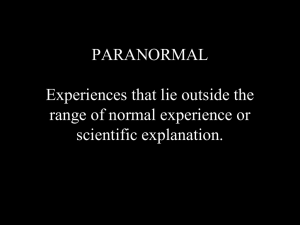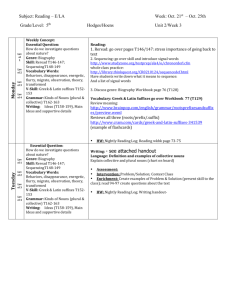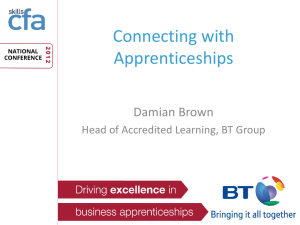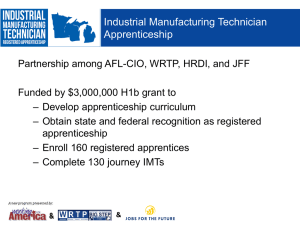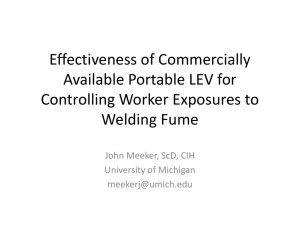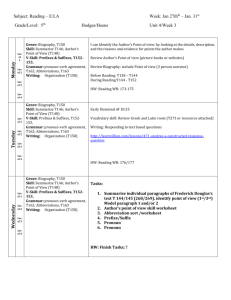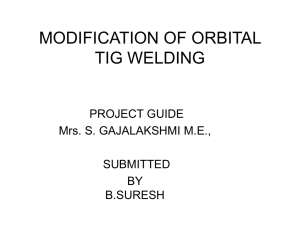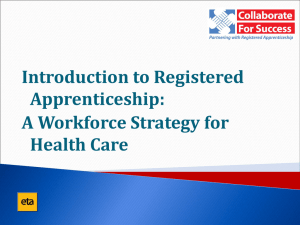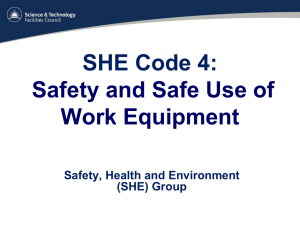PowerPoint
advertisement
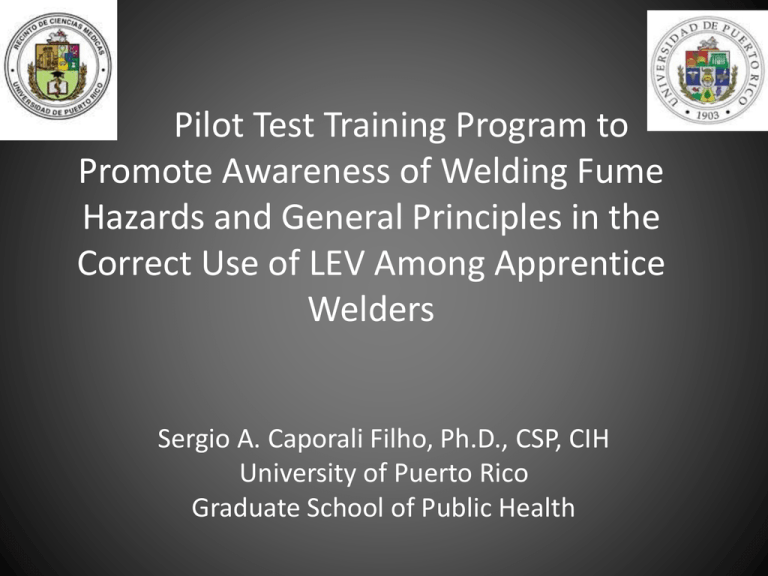
Pilot Test Training Program to Promote Awareness of Welding Fume Hazards and General Principles in the Correct Use of LEV Among Apprentice Welders Sergio A. Caporali Filho, Ph.D., CSP, CIH University of Puerto Rico Graduate School of Public Health This Study was sponsored by Center for Construction Research and Training, CPWR as part of project: Adoptions of Innovations to Minimize Exposure to Dusts and Fumes in Construction, (AIMs) Study Objective • Develop, validate, and test training materials for their effectiveness in promoting the development and retention of knowledge: – On welding processes – On health effects associated with welding fumes exposure – Regulations on the subject – LEV use Methodology • Materials Development – Online survey to assess needs for content – First exposure to Apprentice Center in Philadelphia – Revised and presented for content validation in Apprentice Center in Atlanta • Pilot test in two regions across the US (CO and OH) • Evaluation (quiz, questionnaire, hands-on) – Pre – Post – Retention • Revise and pack training materials to make them available for training centers instructors Training Content • Introduction • Gases, fumes & related welding fume hazards • Measuring and evaluating exposure to welding fumes • Preventing welding fume exposure and the role of OSHA • LEV system components, design & use • Evaluating performance • Using OSHA & why your employer should use LEV Training Groups Evaluation Tools - Quiz • • • • General Knowledge Regulations Health Effects LEV Evaluation Tools - Questionnaire • Familiarity with LEV • Confidence on the use of LEV • Awareness of operating and environmental parameters affecting LEV performance • Level of understanding on general knowledge , health effects, OSHA regulations, and LEV operation and pros and cons • Perspective on the possibility of using LEV’s in the workplace, and their effect on the work Evaluation Tools – Hands On Evaluation • Random sample of apprentices to weld on standardized experimental specimen – Denver, CO & Cambridge, OH 2 feet of 2” Schedule 40 steel pipe coupons welded with 1/8” 7018 electrode at 115 amp DC reverse polarity Evaluation Tools-Hands On Evaluation • Samples taken with TSI AM 510 Real Time Aerosol Monitors connected to DorrOliver Cyclones at 1.7 lpm. • Samples were taken with Dorr-Oliver cyclones clipped to apprentices’ shirt outside welding helmet ` Evaluation Tools-Hands On Evaluation • Local Exhaust Ventilation systems were available in every welding booth Data Analysis (Preliminary) • Pair T-test on quiz scores: – Before and after the training • Pair T-test on apprentice respirable particulate exposures (% exposure reduction): – Before and after the training – Before and 2-5 months after training (retention) • Pair T-test on questionnaire semi-quantitative responses: – Before and after the training (Denver so far) • Apply AIHA Exposure Assessment Model to characterize respirable particulate exposure in apprentice welders: – Before, right after the training, and 2-5 months after training Preliminary Results (Quiz) Preliminary Results (Quiz) Preliminary Results (Quiz) • Quiz scores right after the training were statistically higher than right before the training (Paired T test with 5% level of significance) – 17% higher in Denver, CO n=8 workers; p-value = 4.83% – 1.5% higher in Cambridge, OH N=19 workers; p-value = 4.99% Preliminary Results (Hands-on) Preliminary Results (Hands-on) Preliminary Results (Hands-on) • Total respirable particulate exposure was statistically lower right after the training and also 2-5 months after the training (paired T test on percent exposure reduction) • Right After the Training – 43% lower after the training (2 centers combined) n=14; p-value = 4.5% – 17% lower after 2-5 months (2 centers combined) n=12; p-value = 4.8% Preliminary Results (Questionnaire) Apprentices’ Preferred Control Method Preliminary Results (Questionnaire) Apprentices’ Level of Understanding of Severity of Welding Fumes Hazard Preliminary Results (Questionnaire) Level of Significance – 5% • 26% ↑ in Apprentices' Self Reported Level Confidence on Their Ability and Knowledge to Use LEV in an Effective Manner • 16% ↑ in Apprentices' Self Reported Level of Awareness with Respect to Operating and Environmental Paramenters • 3.5% ↑ in Apprentice's already high (86%) Rating on the Severity Level Associated with Welding Fumes Hazard • 1% ↑ Apprentices' already high Self Reported Level of Trust (82%) on the Effectiveness of LEV to Control their Welding Fume Exposure Preliminary Results (Questionnaire) - Denver Level of Significance – 5% • 6% ↑ in Apprentices' Self Reported Level of Trust that LEV will not Interfere with Shielding Gases • No change in Apprentices' already low Self Reported Belief they will be able to use LEV on the job • 12% ↑ in Apprentices' Self Reported Degree to which they believe OSHA Standards support the use of LEV's on the job • No change in Apprentices' already low Self Reported Degree to which they believe LEV use affects their Productivity Applying AIHA Exposure Assessment Model • Idealized Distribution of Respirable particulate Exposure – Right Before the Training – Right After the Training – 2-5 Months After the Training Particulate Exposures OSHA PEL for Respirable Particulate Particulate Exposures OSHA PEL for Respirable Particulate Discussion of Results • Questionnaire results clearly indicate that the topics covered by the training materials are appropriate and in general terms well grasped by the audience: – – – – – Confidence in the use of LEV increased Awareness of Welding Fumes Hazards increased Preference for LEV over Resp. Protection increased Understanding the role of OSHA increased Understanding employers’ responsibilities increased • Expectation to be able to use LEV in the workplace has not increased and was low to begin with! Discussion of Results • Quiz Scores, although statistically higher after training, were not what we expected! A detailed revision of quiz questions and apprentices’ answers was made…. • Some of the poor performance may have been due to: – Poor choice of answer alternatives – Confusing alternative “all of the above” – Poor choice of words in question text “least likely to” – Apprentices’ priorities in paying attention to information “ACGIH versus AWS” Discussion of Results • Quiz Scores: Several of the mistakes made in the quiz after training can be minimized by adding a “hands on” component in the training itself to explain important LEV parameters and usage Discussion of Results • Hands-on evaluation seemed to be affected by the LEV system layout and flexibility – Exposure estimates were lower in Denver, CO, as compared to Cambridge, OH. • Hands-on evaluation results could be higher if we had a hands-on component during the training demonstrating both the parameters and the correct use of LEV’s Conclusion Remaining Tasks to be Done • Review training materials to include video on hands on component • Review and change quiz questions to avoid confusing • Deploy training in Apprentice Centers and through CPWR network Acknowledgments • Center to Protect Workers’ Rights, CPWR – Pam Susi, AIMS Project Director • Boilermakers Local 101 Apprentice Center, Denver CO – Mr. Tim Ruth – Mark Garret • Pipefitters Local 495 Apprentice Center, Cambridge OH – Mr. James Young • TSI Inc. – Mr. Greg Olson Aknowledgments • Training Advisory Group Members – Mark Garret – Mike Flynn – Carol Stephenson – Reps from Pipefitters, Boilermakers, Sheet Metal Workers Thank You! Sergio A. Caporali Filho, Ph.D., CSP, CIH University of Puerto Rico Graduate School of Public Health sergio.caporali@upr.edu 787-758-2525, ext 1438
